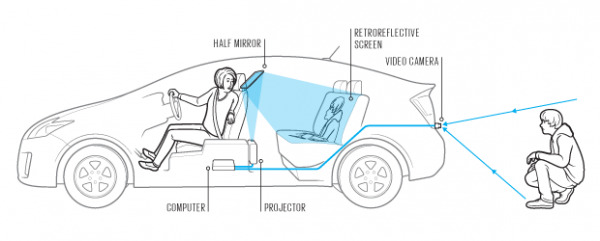"Transparent Cockpit" AR Could Fix Driver Blind Spots
Who says augmented reality is just for games or entertainment? The same ideas and technologies that allows us to superimpose virtual images onto real objects in almost realistic fashion could very well save lives in the future. Take, for example, this "transparent car" concept from researchers from Keio University in Japan, a system that could potentially work around drivers' blind spots, letting them see crucial information that are otherwise occluded to them by doors, windows, ceilings or floors, giving them the details that they need to make that life-saving decision.
The idea is simple in theory. A camera would record objects outside the car and a projector would then display them on doors and floors, giving the illusion that they are made of glass or other transparent materials. But as they say, execution is key. Thanks to the physics of light and the design demands of a car's interior, a crude implementation using out of the box equipment would only produce flat, inaccurate and perhaps even more distracting images that would defeat the entire purpose of the system.
Enter "retroreflective projection technology" or RPT, a new type of screen that was developed by said researches. RPT solves many of the hurdles that traditional screens or projection systems would present in this type of setup. It is made up of 50 micro-meter glass beads that reflect light in the same axis that it was projected in, which helps in completing a stereoscopic 3D image of objects recorded by the camera. The screen can also be draped over any surface, so it can conform to the design of a car's interiors such as doors and seats. Add in a half-mirror and the illusion is complete.

The researchers have tested the system on a Toyota Prius, projecting the whole scenery behind the car, which is of course usually occluded by the car's chassis, onto the backseat. This works even if there are people seated there. According to the researchers, this allows drivers to use a more "natural" behavior, that is, looking behind the car, when backing up, for example, instead of a rather artificial one like viewing camera footage on a dashboard. Whether or not this design helps increase road safety or actually just increases driver distraction is something that needs to be tested further.
RPT, however, can have uses besides cars. It can, for example be used for gloves to give factory workers a more complete view of what they are working on instead of having parts of it hidden by hands. Another use is for superimposing X-ray images on patients undergoing minimally invasive surgery to give doctors a better reference view. Going back to the entertainment side, RPT can also provide rooms that don't even have windows a view of the outside world. What it can't be used for, however, is for complete camouflage, since the equipment needed to pull it off, which also requires the viewer's participation and knowledge, will definitely fool no one.

SOURCE: IEEE Spectrum
